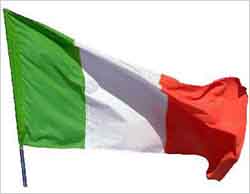Five Roman-era shipwrecks found underwater off Italy
 Washington, July 27 : A team of archaeologists has discovered a trove of five Roman-era shipwrecks deep under the sea off a small Mediterranean island near Italy.
Washington, July 27 : A team of archaeologists has discovered a trove of five Roman-era shipwrecks deep under the sea off a small Mediterranean island near Italy.
According to a report in Discovery News, the find of well-preserved ships, made possible by sonar technology and the use of remotely operated vehicles, includes cargo of largely intact clay vases and pots transporting wine, olive oil, fish sauce and other goods.
Resting untouched between 330 to 490 feet underwater near the small island of Ventotene, which lies 30 miles off the Italian coast halfway between Rome and Naples, the ships date from the 1st century B. C. to the 5th century A. D.
From their cargo, archaeologists from the US group AURORA Trust and Italy's Ministry of Culture, established that the vessels were transporting goods from Italy, Spain and north Africa.
They were probably heading for safe anchorage, but then sunk during a storm.
"Ventotene is a small island in the open sea. It was on major trade routes and was both a safe haven and a danger to shipping," Timmy Gambin, head of archaeology for the Aurora Trust, told Discovery News.
The oldest ship - approximately 18 meters (59 feet) long, 5 meters (16.4 feet) wide and perhaps 2,100 years old - was carrying clay amphorae (a type of ceramic vase with two handles and a long neck narrower than the body) filled with wine from the southern Italian region of Campania.
"They are still stacked in their original position," Gambin said.
Two other ships, one dating from the 1st century A. D. and the other from the 5th century A. D., carried hundreds of Spanish and north African amphorae filled with the "ketchup" of the ancient Romans: a pungent fish sauce called garum.
Another 1st century vessel ship carried a mixed cargo of mortaria (large bowls used to grind grains) and wine from Campania.
The largest of all five vessels was a 2000-year-old ship that measured 20 meters (65 feet) long by 5 meters (16.4 feet) wide - and was carrying a mixed cargo, including Italian wine and glass items and metal bars and cylinders that have yet to be identified.
In order to better understand the shipwrecks, the archaeologists pulled up four mortars and one amphora from two ships.
"They have been transferred to the museum of Ventotene where they will be desalinated, restored and eventually displayed," the AURORA team said.
The survey has shown that the wooden part of the wrecks remains untouched upon the sandy sea bottom, a finding that opens up new opportunities for the preservation of the ships. (ANI)